Comparative Chloroplast Genome Analysis of Rhubarb Botanical Origins and the Development of Specific Identification Markers
Abstract
1. Introduction
2. Results
2.1. Chloroplast Genome Features
2.2. Characterization of Simple Sequence Repeats
2.3. Phylogenetic Analysis
2.4. Comparative Genomic and Candidate Identification Sequence Analysis
3. Discussion
4. Materials and Methods
4.1. Plant Materials and DNA Extraction
4.2. Sequencing, Assembly, and Annotation
4.3. Identification of Repeated Sequences
4.4. Phylogenetic Reconstruction
4.5. Candidate Identification Sequence Screening
Supplementary Materials
Author Contributions
Funding
Acknowledgments
Conflicts of Interest
References
- Sun, Y.; Wang, A.; Wan, D.; Wang, Q.; Liu, J. Rapid Radiation of Rheum (Polygonaceae) and Parallel Evolution of Morphological Traits. Mol. Phylogenet. Evol. 2012, 63, 150–158. [Google Scholar] [CrossRef] [PubMed]
- Yang, S.L.; Yang, Y. Textual Research of the Efficacy of Dahuang. Pharm. Clin. Chin. Mater. Med. 2018, 1, 46–47. [Google Scholar]
- Fu, X.-S.; Chen, F.; Liu, X.H.; Xu, H.; Zhou, Y.Z. Progress in Research of Chemical Constituents and Pharmacological Actions of Rhubarb. Chin. J. New Drugs 2011, 16, 1534–1539. [Google Scholar]
- Zhang, C.; Li, L.; Xiao, Y.Q.; Lin, N.; Liu, C.F.; Tian, G.F.; Chen, D.D. HPLC Simultaneous Determination of Two Anthraquinone-O-Glucosides in Different Botanical Origins of Rhubarb. Chin. J. Pharm. Anal. 2010, 1, 020. [Google Scholar]
- Komatsu, K.; Nagayama, Y.; Tanaka, K.; Ling, Y.; Cai, S.Q.; Omote, T.; Meselhy, M.R. Comparative Study of Chemical Constituents of Rhubarb from Different Origins. Chem. Pharm. Bull. 2006, 54, 1491–1499. [Google Scholar] [CrossRef] [PubMed]
- Wang, X.-M.; Hou, X.-Q.; Zhang, Y.-Q.; Li, Y. Morphological variation in leaf dissection of Rheum palmatum complex (polygonaceae). PLoS ONE 2014, 9, e110760. [Google Scholar] [CrossRef] [PubMed]
- Jiang, K. Identification of Rhubarb. Chin. Med. Mod. Distance Educ. China 2010, 8, 86. [Google Scholar]
- Yang, M.; Zhang, D.; Liu, J.; Zheng, J. A Molecular Marker That Is Specific to Medicinal Rhubarb Based on Chloroplast Trnl/Trnf Sequences. Planta Med. 2001, 67, 784–786. [Google Scholar] [CrossRef] [PubMed]
- Song, J.; Yao, H.; Li, Y.; Li, X.; Lin, Y.; Liu, C.; Han, J.; Xie, C.; Chen, S. Authentication of the Family Polygonaceae in Chinese Pharmacopoeia by DNA Barcoding Technique. J. Ethnopharmacol. 2009, 124, 434–439. [Google Scholar] [CrossRef] [PubMed]
- Yang, D.Y.; Fushimi, H.; Cai, S.Q.; Komatsu, K. Molecular Analysis of Rheum Species Used as Rhei Rhizoma Based on the Chloroplast Matk Gene Sequence and Its Application for Identification. Biol. Pharm. Bull. 2004, 27, 375–383. [Google Scholar] [CrossRef] [PubMed]
- Palmer, J.D. Comparative Organization of Chloroplast Genomes. Ann. Rev. Genet. 1985, 19, 325–354. [Google Scholar] [CrossRef] [PubMed]
- Wang, R.-J.; Cheng, C.-L.; Chang, C.-C.; Wu, C.-L.; Su, T.-M.; Chaw, S.-M. Dynamics and evolution of the inverted repeat-large single copy junctions in the chloroplast genomes of monocots. BMC Evol. Biol. 2008, 8, 36. [Google Scholar] [CrossRef] [PubMed]
- Li, X.; Gao, H.; Wang, Y.; Song, J.; Henry, R.; Wu, H.; Hu, Z.; Yao, H.; Luo, H.; Luo, K. Complete Chloroplast Genome Sequence of Magnolia Grandiflora and Comparative Analysis with Related Species. Sci. China Life Sci. 2013, 56, 189–198. [Google Scholar] [CrossRef] [PubMed]
- Jin, G.H.; Chen, S.; Yi, T.; Zhang, S. Characterization of the Complete Chloroplast Genome of Apple. Plant Divers. Resour. 2014, 36, 468–484. [Google Scholar]
- Fan, K.; Sun, X.J.; Huang, M.; Wang, X.M. The Complete Chloroplast Genome Sequence of the Medicinal Plant Rheum Palmatum L. (Polygonaceae). Mitogenome DNA Part A 2016, 27, 2935–2936. [Google Scholar]
- Raman, G.; Choi, K.; Park, S. Phylogenetic relationships of the fern Cyrtomium falcatum (dryopteridaceae) from dokdo island, sea of east Japan, based on chloroplast genome sequencing. Genes 2016, 7, 115. [Google Scholar] [CrossRef] [PubMed]
- Frazer, K.A.; Pachter, L.; Poliakov, A.; Rubin, E.M.; Dubchak, I. VISTA: Computational Tools for Comparative Genomics. Nucleic Acids Res. 2004, 32, W273–W279. [Google Scholar] [CrossRef] [PubMed]
- Dong, W.; Liu, J.; Yu, J.; Wang, L.; Zhou, S. Highly variable chloroplast markers for evaluating plant phylogeny at low taxonomic levels and for DNA barcoding. PLoS ONE 2012, 7, e35071. [Google Scholar] [CrossRef] [PubMed]
- Hollingsworth, P.M.; Graham, S.W.; Little, D.P. Choosing and Using a Plant DNA Barcode. PLoS ONE 2011, 6, e19254. [Google Scholar] [CrossRef] [PubMed]
- Vijayan, K.; Tsou, C.H. DNA Barcoding in Plants: Taxonomy in a New Perspective. Curr. Sci. 2010, 99, 1530–1541. [Google Scholar]
- Heinze, B. A Database of PCR Primers for the Chloroplast Genomes of Higher Plants. Plant Methods 2007, 3, 4. [Google Scholar] [CrossRef] [PubMed]
- Kane, N.C.; Cronk, Q. Botany without Borders: Barcoding in Focus. Mol. Ecol. 2008, 17, 5175–5176. [Google Scholar] [CrossRef] [PubMed]
- Parks, M.; Cronn, R.; Liston, A. Increasing phylogenetic resolution at low taxonomic levels using massively parallel sequencing of chloroplast genomes. BMC Biol. 2009, 7, 84. [Google Scholar] [CrossRef] [PubMed]
- Huang, C.Y.; Grünheit, N.; Ahmadinejad, N.; Timmis, J.N.; Martin, W. Mutational Decay and Age of Chloroplast and Mitochondrial Genomes Transferred Recently to Angiosperm Nuclear Chromosomes. Plant Physiol. 2005, 138, 1723–1733. [Google Scholar] [CrossRef] [PubMed]
- Li, X.; Yang, Y.; Henry, R.J.; Rossetto, M.; Wang, Y.; Chen, S. Plant DNA Barcoding: From Gene to Genome. Biol. Rev. Camb. Philos. Soc. 2015, 90, 157–166. [Google Scholar] [CrossRef] [PubMed]
- Kane, N.; Sveinsson, S.; Dempewolf, H.; Yang, J.Y.; Zhang, D.; Engels, J.M.M.; Cronk, Q. Ultra-barcoding in cacao (theobroma spp.; malvaceae) using whole chloroplast genomes and nuclear ribosomal DNA. Am. J. Bot. 2012, 99, 320–329. [Google Scholar] [CrossRef] [PubMed]
- Stull, G.W.; Moore, M.J.; Mandala, V.S.; Douglas, N.A.; Kates, H.-R.; Qi, X.; Brockington, S.F.; Soltis, P.S.; Soltis, D.E.; Gitzendanner, M.A. A targeted enrichment strategy for massively parallel sequencing of angiosperm plastid genomes. Appl. Plant Sci. 2013, 1, 1200497. [Google Scholar] [CrossRef] [PubMed]
- Doorduin, L.; Gravendeel, B.; Lammers, Y.; Ariyurek, Y.; Chin-A-Woeng, T.; Vrieling, K. The complete chloroplast genome of 17 individuals of pest species Jacobaea vulgaris: SNPs, microsatellites and barcoding markers for population and phylogenetic studies. DNA Res. 2011, 18, 93–105. [Google Scholar] [CrossRef] [PubMed]
- Krawczyk, K.; Nobis, M.; Myszczyński, K.; Klichowska, E.; Sawicki, J. Plastid Super-Barcodes as a Tool for Species Discrimination in Feather Grasses (Poaceae: Stipa). Sci. Rep. 2018, 8, 1924. [Google Scholar] [CrossRef] [PubMed]
- Jheng, C.-F.; Chen, T.-C.; Lin, J.-Y.; Chen, T.-C.; Wu, W.-L.; Chang, C.-C. The comparative chloroplast genomic analysis of photosynthetic orchids and developing DNA markers to distinguish Phalaenopsis orchids. Plant Sci. 2012, 190, 62–73. [Google Scholar] [CrossRef] [PubMed]
- Zhang, X.; Zhou, T.; Kanwal, N.; Zhao, Y.; Bai, G.; Zhao, G. Completion of Eight Gynostemma BL. (Cucurbitaceae) Chloroplast Genomes: Characterization, Comparative Analysis, and Phylogenetic Relationships. Front. Plant Sci. 2017, 8, 1583. [Google Scholar] [CrossRef] [PubMed]
- Sandbrink, J.M.; Vellekoop, P.; Van Ham, R.; Van Brederode, J. A Method for Evolutionary Studies on Rflp of Chloroplast DNA, Applicable to a Range of Plant Species. Biochem. Syst. Ecol. 1989, 17, 45–49. [Google Scholar] [CrossRef]
- Doyle, J.J. A Rapid DNA Isolation Procedure for Small Quantities of Fresh Leaf Tissue. Phytochem. Bull. 1987, 19, 11–15. [Google Scholar]
- Patel, R.K.; Jain, M. Ngs Qc Toolkit: A Toolkit for Quality Control of Next Generation Sequencing Data. PLoS ONE 2012, 7, e30619. [Google Scholar] [CrossRef] [PubMed]
- Kearse, M.; Moir, R.; Wilson, A.; Stones-Havas, S.; Cheung, M.; Sturrock, S.; Buxton, S.; Cooper, A.; Markowitz, S.; Duran, C.; et al. Geneious basic: An integrated and extendable desktop software platform for the organization and analysis of sequence data. Bioinformatics 2012, 28, 1647–1649. [Google Scholar] [CrossRef] [PubMed]
- Altschul, S.F.; Gish, W.; Miller, W.; Myers, E.W.; Lipman, D.J. Basic Local Alignment Search Tool. J. Mol. Biol. 1990, 215, 403–410. [Google Scholar] [CrossRef]
- Wyman, S.K.; Jansen, R.K.; Boore, J.L. Automatic Annotation of Organellar Genomes with Dogma. Bioinformatics 2004, 20, 3252–3255. [Google Scholar] [CrossRef] [PubMed]
- Liu, C.; Shi, L.; Zhu, Y.; Chen, H.; Zhang, J.; Lin, X.; Guan, X. Cpgavas, an integrated web server for the annotation, visualization, analysis, and genbank submission of completely sequenced chloroplast genome sequences. BMC Genom. 2012, 13, 715. [Google Scholar] [CrossRef] [PubMed]
- Schattner, P.; Brooks, A.N.; Lowe, T.M. The tRNAscan-SE, snoscan and snoGPS web servers for the detection of tRNAs and snoRNAs. Nucleic Acids Res. 2005, 33, W686–W689. [Google Scholar] [CrossRef] [PubMed]
- Lohse, M.; Drechsel, O.; Kahlau, S.; Bock, R. Organellargenomedraw—A suite of tools for generating physical maps of plastid and mitochondrial genomes and visualizing expression data sets. Nucleic Acids Res. 2013, 41, W575–W581. [Google Scholar] [CrossRef] [PubMed]
- Kumar, S.; Stecher, G.; Tamura, K. Mega7: Molecular evolutionary genetics analysis version 7.0 for bigger datasets. Mol. Biol. Evol. 2016, 33, 1870–1874. [Google Scholar] [CrossRef] [PubMed]
- Thiel, T.; Michalek, W.; Varshney, R.; Graner, A. Exploiting EST databases for the development and characterization of gene-derived SSR-markers in barley (Hordeum vulgare L.). Theor. Appl. Genet. 2003, 106, 411–422. [Google Scholar] [CrossRef] [PubMed]
- Kurtz, S.; Choudhuri, J.V.; Ohlebusch, E.; Schleiermacher, C.; Stoye, J.; Giegerich, R. REPuter: The Manifold Applications of Repeat Analysis on a Genomic Scale. Nucleic Acids Res. 2001, 29, 4633–4642. [Google Scholar] [CrossRef] [PubMed]
- Larkin, M.A.; Blackshields, G.; Brown, N.P.; Chenna, R.; McGettigan, P.A.; McWilliam, H.; Valentin, F.; Wallace, I.M.; Wilm, A.; Lopez, R.; et al. Clustal W and clustal X version 2.0. Bioinformatics 2007, 23, 2947–2948. [Google Scholar] [CrossRef] [PubMed]
- Katoh, K.; Standley, D.M. Mafft multiple sequence alignment software version 7: Improvements in performance and usability. Mol. Biol. Evol. 2013, 30, 772–780. [Google Scholar] [CrossRef] [PubMed]
Sample Availability: Sequences date of three Rheum species (R. officinale, R. palmatum and R. tanguticum) are available from the authors. |
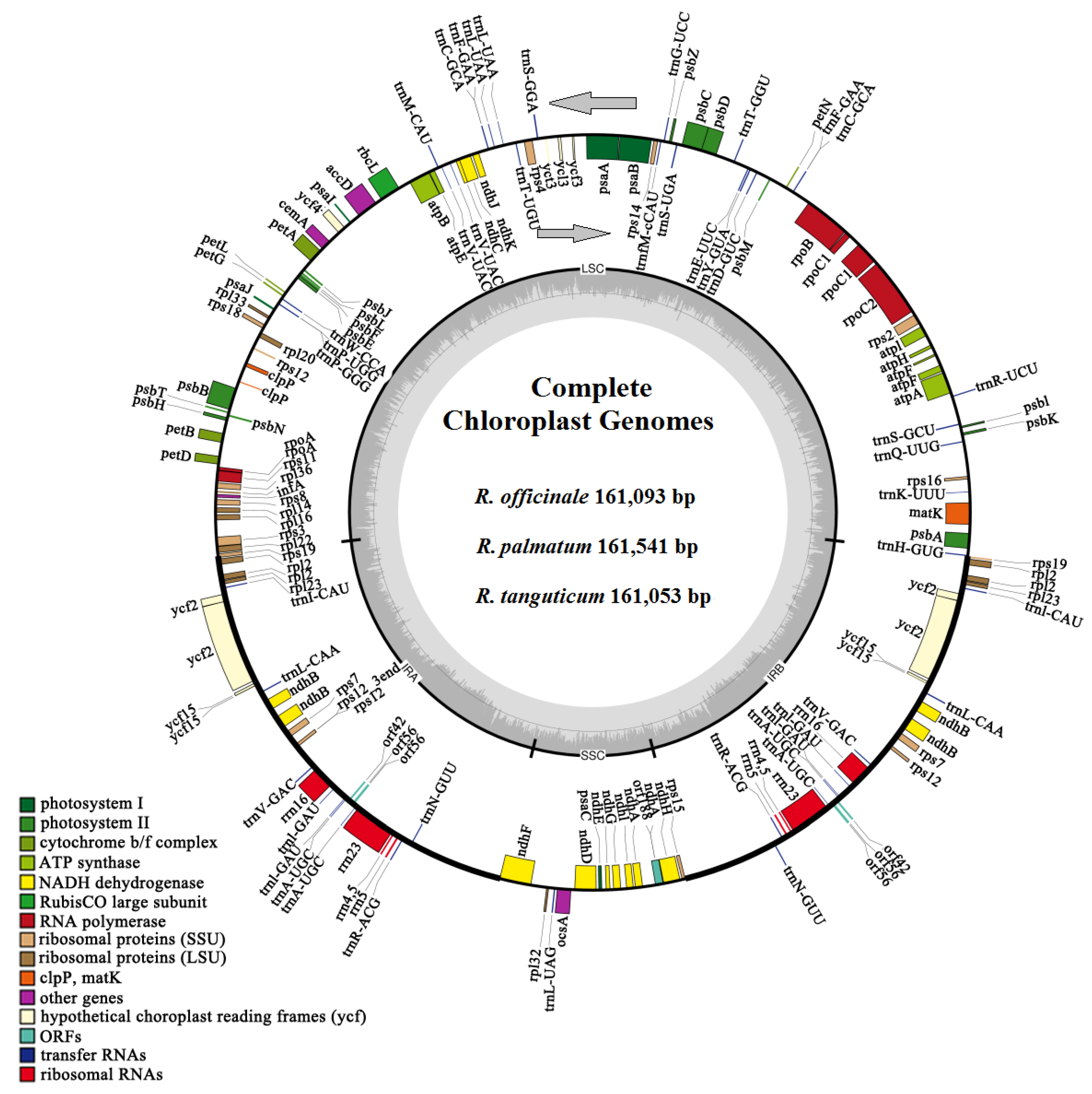
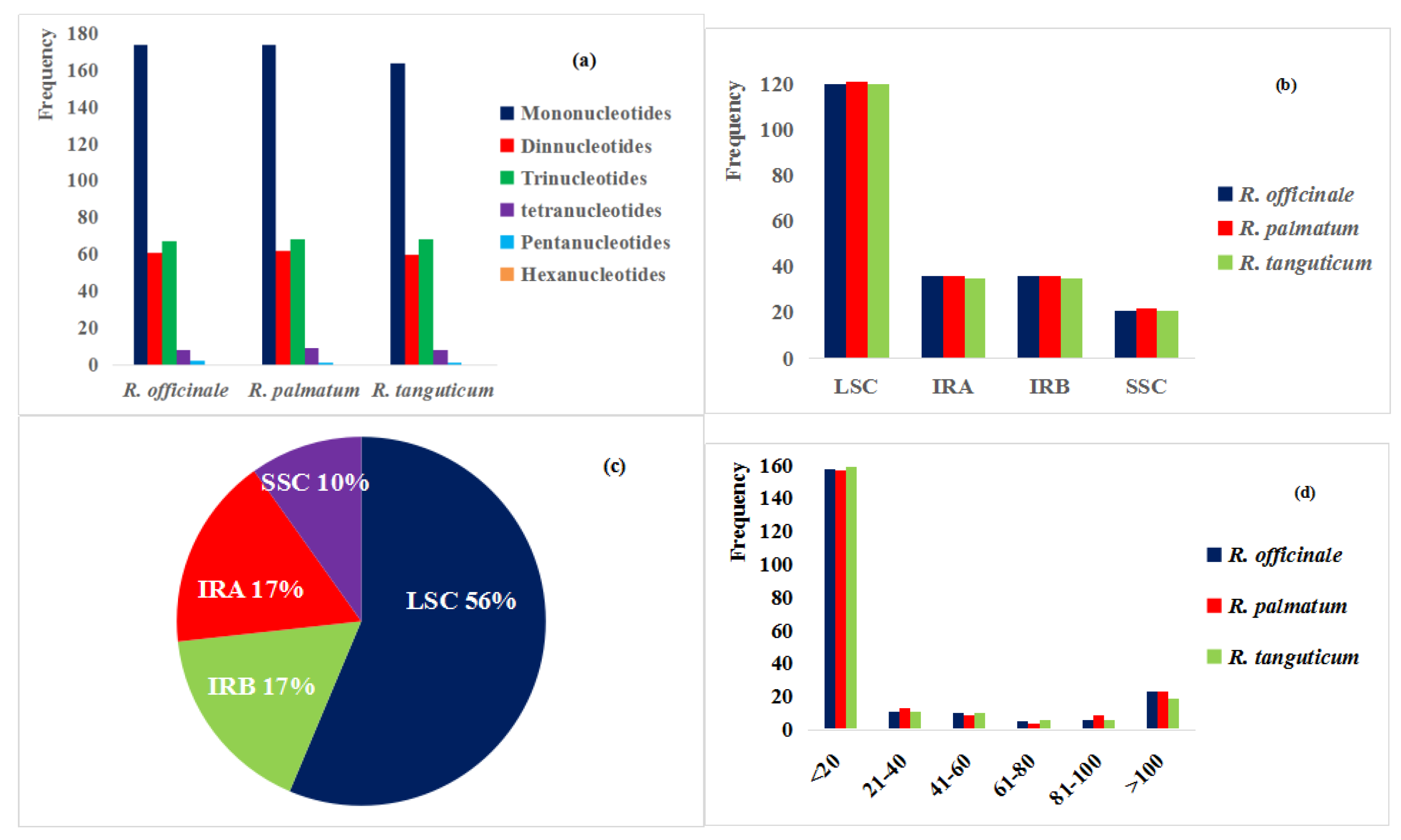
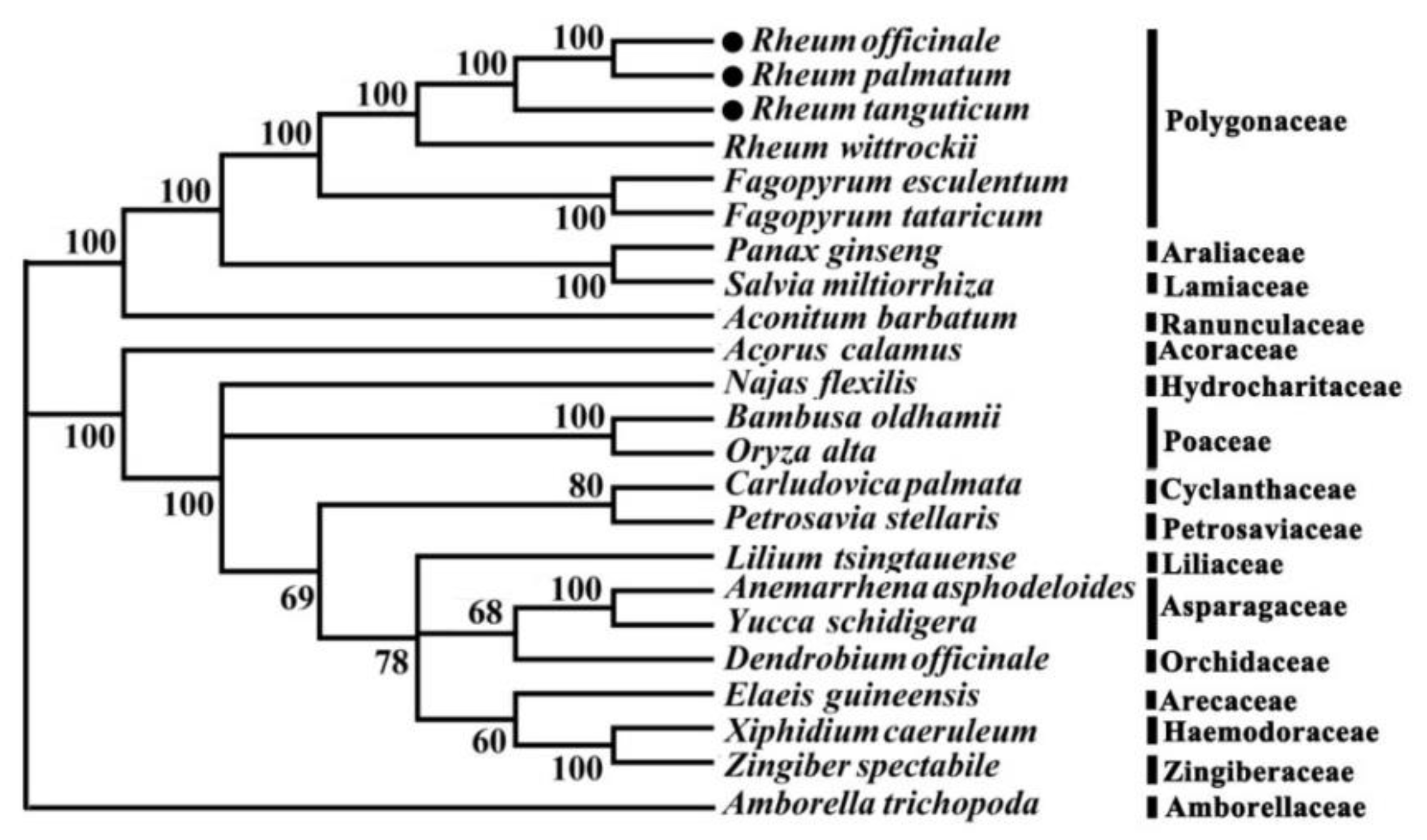
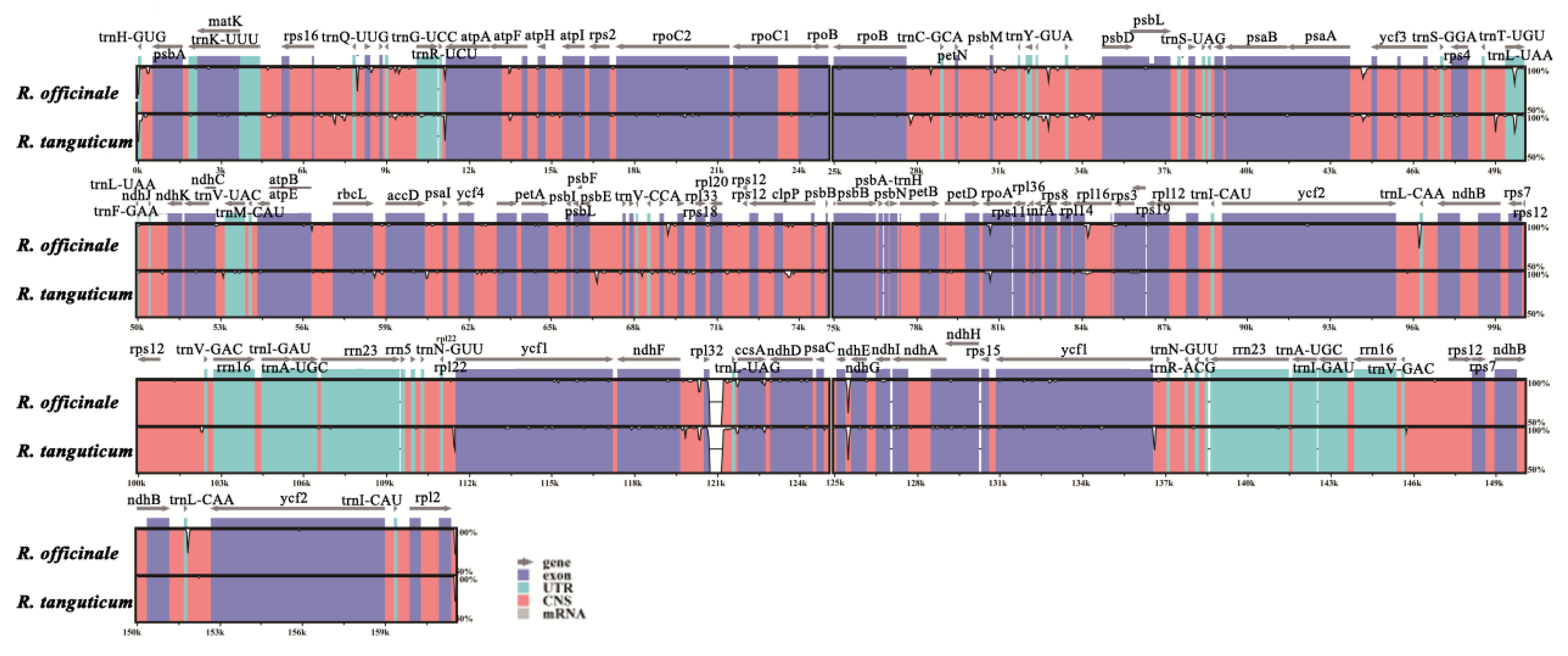
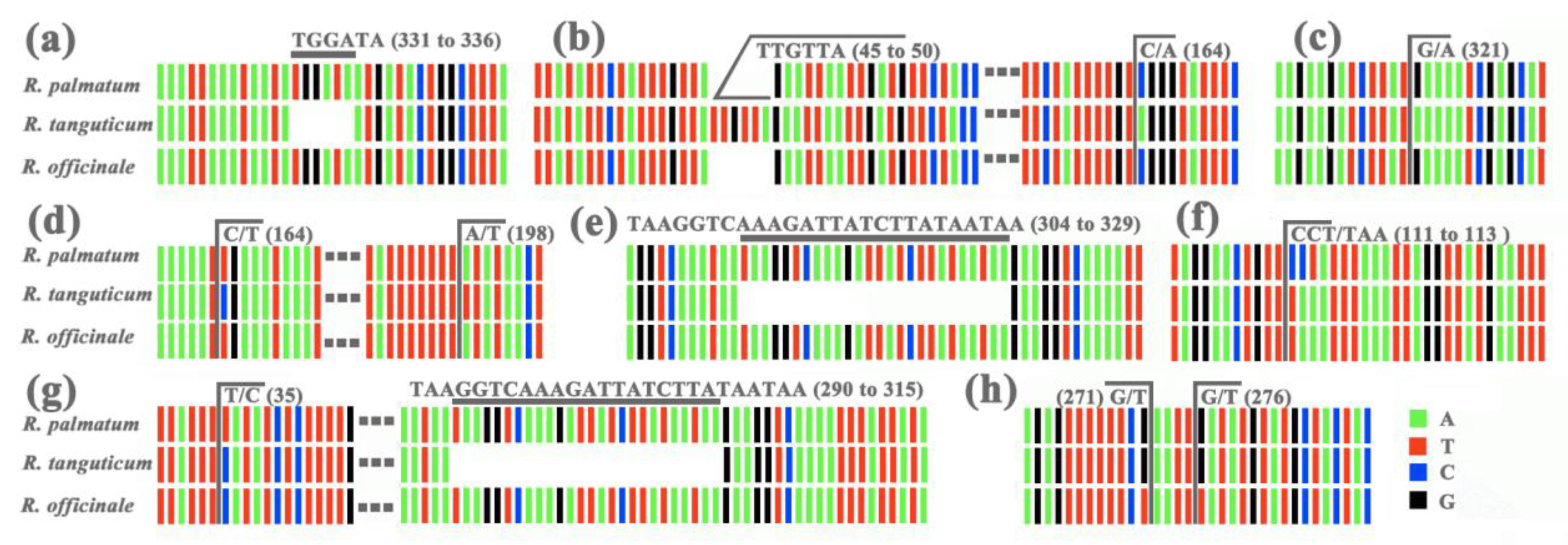
| R. officinale | R. palmatum | R. tanguticum | |
|---|---|---|---|
| Location | Qinghai | Sichuan | Gansu |
| Accession number in GenBank | MH572012 | KR816224 | MH572013 |
| Total clean read | 820,613 kb | 644,941 kb | 685,879 kb |
| N50 of contigs (bp) | 86,523 | 86,483 | 86,439 |
| Total chloroplast DNA size (bp) | 161,093 | 161,541 | 161,053 |
| LSC size (bp) | 86,609 | 86,518 | 86,604 |
| IR size (bp) | 30,956 | 30,956 | 30,961 |
| SSC size (bp) | 12,750 | 13,111 | 13,147 |
| Total number of genes | 131 | 130 | 129 |
| Number of different protein-coding genes | 92 | 92 | 92 |
| Number of different tRNA genes | 31 | 30 | 29 |
| Number of different rRNA genes | 8 | 8 | 8 |
| GC content (%) | 37.3 | 37.3 | 37.3 |
| GC content of LSC (%) | 35.3 | 35.4 | 35.4 |
| GC content of IR (%) | 41.1 | 41 | 41.1 |
| GC content of SSC (%) | 32.5 | 32.5 | 32.6 |
| Group of Genes | Name of Gene |
|---|---|
| Transfer RNAs (31) | trnC-GCA, trnD-GTC, trnE-TTC, trnF-GAA, trnfM-CAT, trnG-GCC, trnH-GTG, trnI-CAT (x2), trnI-GAT *, trnL-CAA (x2), trnL-TAG, trnL-TAG *, trnM-CAT, trnN-GTT (x2), trnP-TGG, trnQ-TTG, trnR-ACG (x2), trnR-TCT, trnS-GGA, trnS-GCT, trnS-TGA, trnT-GGT, trnT-TGT, trnV-GAC (x2), trnW-CCA, trnY-GTA, |
| photosystem I (5) | psaA, psaB, psaC, psaI, psaJ |
| Assembly/stability of photosystem I (2) | ycf3 **, ycf4 |
| photosystem II (15) | psbA, psbB, psbC, psbD, psbE, psbF, psbH, psbI, psbJ, psbK, psbL, psbM, psbN, psbT, psbZ |
| Maturase (1) | matK |
| Ribosomal protein (25) | rps16, rps2, rps14, rps4, rpl33, rps18, rpl20, rps11, rpl36, rps8, rpl14, rpl16, rps3, rpl22, rps19, rps15, rps12 (x3), rpl2 * (x2), rpl23 (x2), rps7 (x2), |
| cytochrome b6/f complex (6) | petA, petB, petD, petG, petL, petN |
| ATP synthase (6) | atpA, atpB, atpE, atpF *, atpH, atpI |
| RNA polymerase (4) | rpoC2, rpoC1 *, rpoB, rpoA |
| NADH dehydrogenase (13) | ndhA *, ndhB * (x2), ndhC, ndhD, ndhE, ndhF, ndhG, ndhH, ndhI, ndhJ, ndhK (x2) |
| Rubisco large subunit (1) | rbcL |
| Acetyl-CoA carboxylase (1) | accD |
| envelope membrane protein (1) | cemA |
| ATP-dependent protease subunit (1) | clpP ** |
| translation initiation factor (1) | infA |
| Conserved reading frames (ycfs) (8) | ycf2 (x2), ycf15 (1N) (x2), ycf15 (x2), ycf1 (1N) (x2) |
| Ribosomal RNAs (8) | rrn16S (x2), rrn23S (x2), rrn4.5S (x2), rrn5S (x2) |
| c-type cytochrome biogenesis (1) | ccsA |
| SSR nr. | SSR Type | SSR | Size | Star | End | Location |
|---|---|---|---|---|---|---|
| 2 | p1 | (A)10 | 10 | 1883 | 1892 | CNS |
| 3 | p1 | (T)11 | 11 | 2053 | 2063 | CNS |
| 4 | p4 | (TGAT)3 | 12 | 2688 | 2699 | matK |
| 5 | p1 | (T)12 | 12 | 3040 | 3051 | matK |
| 6 | p1 | (T)11 | 11 | 3505 | 3515 | matK |
| 8 | p1 | (A)12 | 12 | 4763 | 4774 | CNS |
| 10 | p1 | (T)10 | 10 | 5538 | 5547 | CNS |
| 16 | p1 | (A)12 | 12 | 8117 | 8128 | CNS |
| 23 | p4 | (GTCT)3 | 12 | 12207 | 12218 | atpA |
| 32 | p1 | (T)11 | 11 | 19306 | 19316 | rpoC2 |
| 35 | p2 | (AT)5 | 10 | 20683 | 20692 | rpoC2 |
| 49 | p1 | (T)10 | 10 | 33669 | 33678 | CNS |
| 50 | p1 | (A)12 | 12 | 34263 | 34274 | CNS |
| 57 | p1 | (A)10 | 10 | 39162 | 39171 | CNS |
| 62 | p1 | (T)10 | 10 | 45369 | 45378 | CNS |
| 63 | p3 | (AAT)4 | 12 | 46315 | 46326 | CNS |
| 65 | p4 | (TTGG)3 | 12 | 46894 | 46905 | CNS |
| 87 | p4 | (TATT)3 | 12 | 61268 | 61279 | CNS |
| 90 | p2 | (TA)5 | 10 | 63994 | 64003 | petA |
| 97 | p1 | (A)10 | 10 | 67687 | 67696 | petL-CNS |
| 116 | p1 | (T)15 | 15 | 82003 | 82017 | CNS |
| 120 | p1 | (T)12 | 12 | 86283 | 86294 | rpl22 |
| 125 | p1 | (A)10 | 10 | 89370 | 89379 | ycf2 |
| 129 | p3 | (CTT)4 | 12 | 92498 | 92509 | ycf2 |
| 151 | p1 | (A)16 | 16 | 114057 | 114072 | ycf1 |
| 158 | p1 | (A)10 | 10 | 117661 | 117670 | ndhF |
| 165 | p1 | (T)10 | 10 | 120389 | 120398 | CNS |
| 171 | p4 | (AATA)3 | 12 | 122749 | 122760 | ndhD |
| 174 | p2 | (AT)5 | 10 | 124108 | 124117 | CNS |
| 175 | p1 | (A)10 | 10 | 125400 | 125409 | ndhG |
| 183 | p1 | (T)16 | 16 | 133545 | 133560 | ycf1 |
| 205 | p3 | (AAG)4 | 12 | 155108 | 155119 | ycf2 |
| 209 | p1 | (T)10 | 10 | 158238 | 158247 | ycf2 |
© 2018 by the authors. Licensee MDPI, Basel, Switzerland. This article is an open access article distributed under the terms and conditions of the Creative Commons Attribution (CC BY) license (http://creativecommons.org/licenses/by/4.0/).
Share and Cite
Zhou, Y.; Nie, J.; Xiao, L.; Hu, Z.; Wang, B. Comparative Chloroplast Genome Analysis of Rhubarb Botanical Origins and the Development of Specific Identification Markers. Molecules 2018, 23, 2811. https://doi.org/10.3390/molecules23112811
Zhou Y, Nie J, Xiao L, Hu Z, Wang B. Comparative Chloroplast Genome Analysis of Rhubarb Botanical Origins and the Development of Specific Identification Markers. Molecules. 2018; 23(11):2811. https://doi.org/10.3390/molecules23112811
Chicago/Turabian StyleZhou, Yuxin, Jing Nie, Ling Xiao, Zhigang Hu, and Bo Wang. 2018. "Comparative Chloroplast Genome Analysis of Rhubarb Botanical Origins and the Development of Specific Identification Markers" Molecules 23, no. 11: 2811. https://doi.org/10.3390/molecules23112811
APA StyleZhou, Y., Nie, J., Xiao, L., Hu, Z., & Wang, B. (2018). Comparative Chloroplast Genome Analysis of Rhubarb Botanical Origins and the Development of Specific Identification Markers. Molecules, 23(11), 2811. https://doi.org/10.3390/molecules23112811




